Porcelain Insulator News
by Jack H. Tod
Reprinted from "INSULATORS - Crown Jewels of the Wire", September 1973, page 18
Preferably direct porcelain news items and questions directly to Jack H. Tod,
3427 N. 47th Place, Phoenix, Ariz. 85018. Reply stamp is appreciated. All mail
will be answered, and the most newsworthy items and questions of general
interest will be published as space permits.
ANOTHER PUZZLE SOLVED
It has always been a deep mystery to me why the chunky U-174 insulator was
so different from all the similar and smaller styles such as the U-172 shown
here, and made by most other porcelain companies
.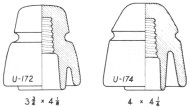
This Pinco design was also unusual in that it comes with the patent notice
marking shown at the right, and this is peculiar to all the other fairly modern
pin types. Furthermore, I have had for some years a specimen which has the major
portion of the recess between the petticoat and skirt unglazed.

In making a more thorough search of the Pinco drawing files in Lima, N.Y. on
April 11, 1973 I found the drawing #679 reproduced (reduced) here, and the
mystery is now solved. This insulator was designed as a "Dry Spot"
insulator - each insulator having a dry spot for one tap lead wire.
To complete the story, I acquired a specimen at the Hutchinson national show
which still had the lead wire held in place with a tar-like capping compound.
This is the first specimen I have seen with the dry-spot wire in place and
showing it was used for that purpose.
It is interesting to note that the U-188 Dry-Spot manufactured by Square-D
Co. and sold by Automatic Electric Co. and American Electric Co. was first
announced by A.E. Co. on Feb 1, 1929, and the Pinco drawing of their Dry-Spot is
clearly dated Sep 30, 1925. This means that Pinco may have had the first idea
for such an insulator design to be used on the standard 1" crossarm pins.

Whereas the specially designed U-188 makes dry spot provisions for both phone
tap lead wires within one insulator, the earlier Pinco version had only one lead
wire per insulator. It would have required a pair of these special U-174
insulators for each phone tap.
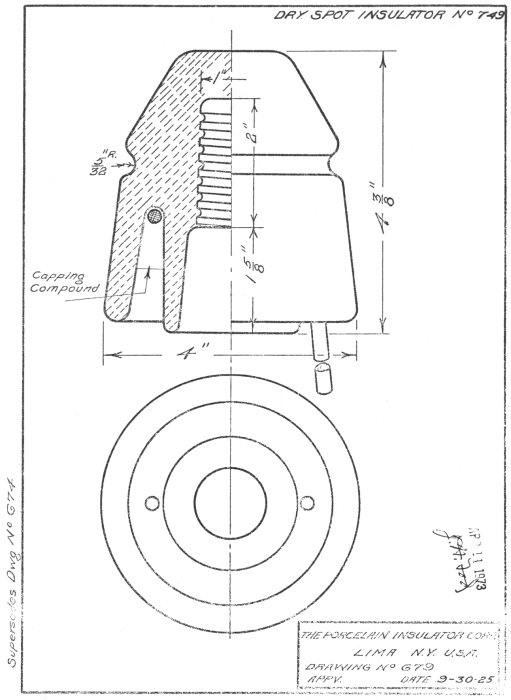
For readers unfamiliar with the use of "Dry-Spot" insulators, we
are including on the following page an excerpt from "Porcelain Insulators
Guide Book for Collectors" and which should explain their use.
This is such an unusual and interesting insulator to collectors that an
explanation of its use is in order. For many years, various schemes were used to
provide the maximum number of communications circuits over a given number of
pairs of open wire. Without getting into details of all the balancing circuitry,
a simplified diagram is shown below for a method of obtaining what is termed a
"phantom" circuit on two existing pairs. Note that circuits Number I
and Number 2 are over normal wire lines, but no additional pole wires are needed
for the phantom circuit. Each conductor must be carefully balanced to ground to
avoid crosstalk between the various circuits.
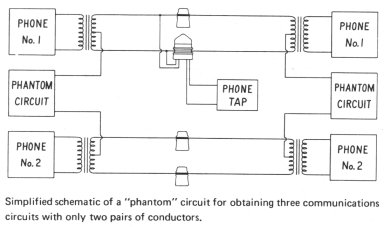
If an intermediate telephone tap is made in one of the metallic pairs as
shown, the circuit can become unbalanced when the outer braid of the insulated
"tap wires" becomes wet with rain. This leakage can be prevented by
maintaining a perfectly dry spot of several inches along the outside of the
take-off leads.
This Dry-Spot chamber is made in the form of a pin type insulator for a very
good (and clever) reason. In practice, one of the normal conductor insulators is
removed, and the Dry-Spot is screwed onto the peg in its place - the Dry-Spot
insulator having a tie-wire groove itself to accommodate the line conductor. As
an alternative, the Dry-Spot was mounted on the peg of a transposition bracket
underneath the crossarm. The insulated tap-wires are run through the Dry-Spot
chamber and then connected to the pole line. The top cap of the insulator screws
off to facilitate running the tap wires up into the dry chamber and back out the
bottom.
In recent years much of the railroad communications is handled by radio, and
as the requirement for pole line circuits diminished, the troublesome
"phantom" circuits were naturally the first ones eliminated. I have
heard of linemen removing these insulators because the phone tap worked just as
well without them. True enough, but if this pair was one leg of a phantom
circuit still in use, this would later result in serious crosstalk problems in
wet weather.
FLASH
Rick Lindley, 724 Knollridge Dr., Lewisville, Texas 75067 has come up with an
item which may well turn out to win all honors for the insulator of the year!
This is positively the most exciting thing I've seen for a long time.
Furthermore, Rick says he bought this at an antique store several years ago
for 25 cents and that could possibly stand as an all time record for bargain
purchases anywhere.
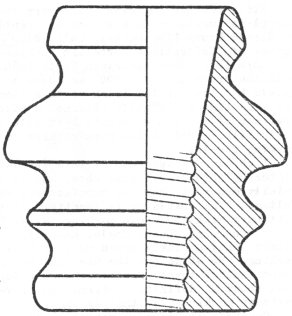
The insulator is similar to the preliminary drawing shown above, and an
accurate drawing is in the process of being made by remote control at this
writing. It is an unmarked specimen, and I would not care to make any guess as
to the manufacturer at this time.
Rick and I agree that this insulator was undoubtedly designed for use as a
transposition on duplexed communications lines (under the crossarms on duplex
pins) and where the line was duplexed with insulators such as the U-84 or
similar items. I had always wondered how transpositions were effected on these
duplexed lines, and this insulator may be the answer. The transpositions could
have been made by the normal underarm brackets holding conventional
transpositions, of course, and this specially designed transposition for duplex
work may well turn out to be a very rare item in the long run.

Rick wanted an estimate of the value of this specimen which he terms "my
favorite porcelain in our collection". It is difficult to assign a value to
desirable unique specimens which do not change hands in a sale, but I told him
that I personally would rather have this specimen for my collection if I had to
pick between it and some of the early porcelain threadless types! If you happen
to be excited by duplex insulators and also by transpositions, this particular
porcelain insulator should really turn you on good. If anyone else ever turns up
another one of these, we'd certainly like to know about it.
Still another important discovery for porcelain insulator fans was made
recently by Gerald Brown (Two Buttes, Colo. 81084), author of "Collectible
Porcelain Insulators".


This is a brown porcelain U-148 beehive with the crown marking "SOO"
as shown above. Gerald had been on the track of this item for some time and
finally obtained a nice specimen of it, but we hadn't been able to definitely
attribute the manufacturer or the marking itself.
I obtained a specimen of this insulator at the Hutchinson National Show, and
it was quickly apparent that the manufacturer was Pittsburg High Voltage. The
insulator is identical to the U-148 made by Pittsburg with the crown marking
"N. A. T. CO.".
Furthermore, Duane Engle, Enderlin, N. Dak. 58027 almost simultaneously asked
me if I knew of this insulator marking. He works for the Soo Line Railroad and
personally found some of these insulators on the Soo lines. This is just about
as definite confirmation as we require on these customer markings, so that is
that.
Customer markings on porcelain pin types are very important to collectors,
possibly even more so than they are on glass insulators. To summarize these
markings known to date:
| Style |
Marking |
Customer |
Manufacturer |
| U-148 |
N.A.T.CO. |
No. Atlant. Tel |
Pittsburg |
| U-148 |
SOO |
Soo Line Railroad |
Pittsburg |
| U-152 |
M P |
Missouri Pacific |
? |
| U-154 |
POSTAL |
Postal
Tel. Co |
Pittsburg |
| U-179* |
P.R.R. |
Penna . Railroad |
Pittsburg |
| U-241A |
JOHNS-MANVILLE |
J. M. Co. |
Pittsburg |
| cables |
JOHNS-MANVILLE |
J. M. Co. |
New Lexington |
| U-239A |
B & O |
Baltimore & Ohio |
? |
| U-474 |
N.E.P. |
New Eng. Pwr (?) |
P.P. Inc. (?) |
*Plus P.R.R. on U-225 and U-529, both very rare.
Dear Jack:
Just a note to report a 2-wire C. S. & I. C 0. cleat marked: C. S. &
I. Co. Any information on this one?
Jud Fisher,
Buffalo, N.Y.

- - - - - - -
Dear Jud:
This is Colonial Sign & Insulator Co., Akron, Ohio, and see the remarks
under the "A. I. & M. CO." item in last month's column. This
marking started in 1904 and when visiting the old plant site this year, I
located some broken #334 cleats with marking "C. S. I. Co." which is
similar to that on your item.
Jack
Dear Mr. Tod:
I have two different pin types with a recess-embossed Westinghouse marking.
One is a brown one Sim U-293 and the other is a cobalt U-288. Have you ever seen
a r-e marking on Westinghouse pin types?

Also, I'm sending print copies of pages from a 1924 Pettingell-Andrews Co.
catalog showing a cut of the Pierce tree insulator. Is this one really different
from the U-187 in the porcelain Universal Style Chart?
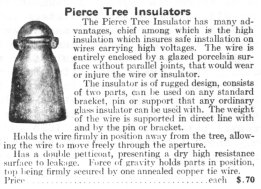 |
Image text:
Pierce Tree Insulators
The Pierce Tree Insulator has many advantages, chief among which is the high
insulation which insures safe installation on wires carrying high voltages. The
wire is entirely enclosed by a glazed porcelain surface without parallel joints,
that would wear or injure the wire or insulator.
The insulator is of rugged design, consists of two parts, can be used on any
standard bracket, or support that any ordinary glass insulator can be used with.
The weight of the wire is supported in direct line with and by the pin or
bracket.
Holds the wire firmly in position away from the tree, allowing the wire to
move freely through the aperture.
Has a double petticoat, presenting a dry high resistance surface to leakage.
Force of gravity holds parts in position, top being firmly secured by one
annealed copper tie wire.
Price ...... each $.70
|
Finally, I also have a U-474 with a clear marking of N.E.P. on the crown ear,
and is there anything definite on this marking yet?
Robin Harrison
R.R.-#l, Box
384
Weare, N.H. 03281
- - - - - - -
Dear Robin:
I have seen jillions of Whse pin types but never one with the recess-embossed
marking like the foil impression of yours. All I have seen have either been
incuse or under-glaze handstamp markings. It would thus be fair to say your Whse
marking is an unusual one.

A collector in Canada reported last year that he had two varieties of the
Pierce U-187 and that one had this milk bottle shape like the Pettingell
catalog. We will consider adding this to the chart as U-187A.
Finally too, we have not attributed the N.E.P. marking for certain. Our best
"wild guess" is New England Power Co., a customer marking. The
insulators appear to be a product of Porcelain Products, Inc., Parkersburg, W.
Va.
Jack
PORCELAINS AT THE 4TH NATIONAL
If you wanted to be where the action was, you should have been at the
Hutchinson, Kansas show! There weren't too many tables devoted exclusively to
porcelain, but virtually every table there had some porcelain - and I mean real
good items too. There was a large variety to suit every collector level, and a
good deal of this was changing hands in swaps and sales.
Two different porcelain 2-piece transpositions changed hands, one for $30 and
the other for $40. There were also many other goodies on hand such as Harloes,
U-390 helmet, some U-393, U-395 Mickey Mice, U-416 upside- downer, Boch patent
items, early Lockes, and many pretty colored cable and distribution types. I
counted no less than 4 of the rare Elliot threadless insulators and may have
missed noticing others. Forrest Jones (New Carlisle, 0.) had on exhibit his
unique U-982 Bennington threadless.

But the whole auditorium really went to buzzing when Gerald Brown (Two
Buttes, Colo.) acquired the unique U-182 in a swap involving some very rare
glass insulators including a screw-top Boston. This U-182 is the Henry Prenzel
patent of April 14, 1895 and is the only known specimen. Gerald and Jeff Osler
(South Bend, Ind.) were on the other end of the swap.
Jack
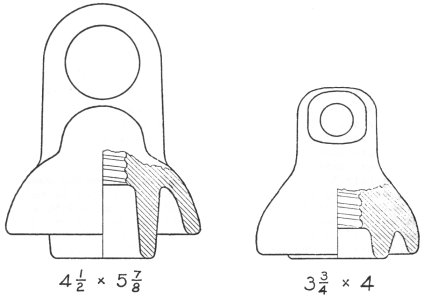
Here are two more new pin type styles which just can't wait. Collectors
inclined towards sticking nicknames on fancy porcelain shapes should have a
field day on these.
Lew Hohn (Rochester, N.Y.) was the first one to get the scent on the tall one
at left above, and I first saw it at the bottle club meeting in Rochester in
April. John DeVolder found it when digging bottles in an old dump. It has a
"wordy" Fred M. Locke marking with the June 7, 1898 patent date. As is
par for the course for Locke patent date markings, this patent has absolutely
nothing to do with this insulator design.
The smaller one at right above was made by Pittsburg High Voltage, and I dug
it at an old Pittsburg fill site near Derry, Pa.
It appears that both these items may have been some form of "slack
wire" insulators, possibly to do with some trolley system, but their exact
use is a complete mystery to me thus far. If anyone has concrete information
about how these items were used, please let us know. We've had pretty good luck
with readers furnishing the answers, and we sure are curious about these wierd pin types.

The 125 new styles of porcelain pin types published last fall in Supplement A
to "Porcelain Insulators Guide Book for Collectors" brought the total
different pin type shapes in the porcelain Universal Style Chart up to 901, and
there may be nearly 100 more new shapes in the next supplement to be published
this winter!
We have continued to publish in this monthly column new shapes which were
exciting and newsworthy even though they would appear later anyway in the U-
chart supplements.
Recently a wide-groove version of the U-393 has been showing up, and this
item will be U-393A in the chart. These groove differences are usually boring to
us, but not when they are on one of our exotic styles like the U-393. This
advance notice will answer those who have asked about these items and will alert
others to watch for both styles.
Thomas cataloged the U-393. Dump digging has confirmed that Pittsburg made
both styles. All known specimens are unmarked and have white glaze. The even
more exotic U-394 hasn't shown up anywhere as far as I know.
Jack
| 